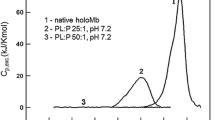Summary
Under zero-trans conditions, the facilitated transport of choline across the erythrocyte membrane is limited by the rate of reorientation of the free carrier; as a result the pH dependence of this step can be investigated, independent of other steps in transport. It is found that as the pH declines (between 8.0 and 6.0) the rate of inward movement of the free carrier rises and the rate of outward movements falls, so that the partition of the free carrier increasingly favors the inward-facing form. When the pH of the cell interior and of the medium are varied independently, the partition responds to the internal but not the external pH. The membrane potential, which varies somewhat as the pH is altered, has no effect on the carrier partition. The analysis of the results indicates that the carrier mobility is dependent on an ionizing group of pK a 6.8, which is exposed on the cytoplasmic surface of the membrane in the inward-facing carrier; in the out-ward-facing carrier the ionizing group appears to be masked, in that its pK a is shifted downward by more than one unit. The observations can be explained by assuming that an ionizing group is located in the wall of a gated channel connecting the substrate site with the cytoplasmic face of the cell membrane.
Similar content being viewed by others
References
Deuticke, B., Bayer, E., Forst, B. 1982. Discrimination of three parallel pathways of lactate transport in the human erythrocyte membrane by inhibitors and kinetic properties.Biochim. Biophys. Acta 684:96–110
Devés, R., Krupka, R.M. 1979. A general kinetic analysis of transport. Tests of the carrier model based on predicted relations among experimental parameters.Biochim. Biophys. Acta 556:533–547
Devés, R., Krupka, R.M. 1979. The binding and translocation steps in transport as related to substrate structure. A study of the choline carrier of erythrocytes.Biochim. Biophys. Acta 557:469–485
Devés, R., Krupka, R.M. 1981. Evidence for a two-state mobile carrier mechanism in erythrocyte choline transport: Effects of substrate analogs on inactivation of the carrier by N-ethylmaleimide.J. Membrane Biol. 61:21–30
Devés, R., Krupka, R.M. 1983. Apparent noncompetitive inhibition of choline transport in erythrocytes by inhibitors bound at the substrate site.J. Membrane Biol. 74:183–189
Edwards, P.A. 1973. Evidence for the carrier model of transport from inhibition by N-ethylmaleimide of choline transport across the human red cell membrane.Biochim. Biophys. Acta 311:123–140
Freedman, J.C., Hoffman, J.F. 1979. The relation between dicarbocyanine dye fluorescence and the membrane potential of human red blood cells set at varying Donnan equilibria.J. Gen. Physiol. 74:187–212
Gunn, R.B., Dalmark, M., Tosteson, D.C., Wieth, J.O. 1973. Characteristics of chloride transport in human red blood cells.J. Gen. Physiol. 61:185–206
Krupka, R.M., Devés, R. 1980. The choline transport system of erythrocytes. Distribution of the free carrier in the membrane.Biochim. Biophys. Acta 600:228–232
Krupka, R.M., Devés, R. 1981. An experimental test for cyclic versus linear transport models.J. Biol. Chem. 256:5410–5416
Krupka, R.M., Devés, R. 1983. Kinetics of inhibition of transport systems.Int. Rev. Cytol. 84:303–352
Krupka, R.M., Devés, R. 1986. Looking for probes of gated channels: Studies of the inhibition of glucose and choline transport in erythrocytes.Can. J. Biochem. Cell Biol. (in press)
Martin, K. 1968. Concentrative accumulation of choline by human erythrocytes.J. Gen. Physiol. 51:497–516
Martin, K. 1971. Some properties of an SH group essential for choline transport in human erythrocytes.J. Physiol. (London) 213:647–664
Wharton, C.W. 1983. Some recent advances in enzyme kinetics.Biochem. Soc. Trans. 11:817–825
Author information
Authors and Affiliations
Rights and permissions
About this article
Cite this article
Devés, R., Reyes, G. & Krupka, R.M. The carrier reorientation step in erythrocyte choline transport: pH effects and the involvement of a carrier ionizing group. J. Membrain Biol. 93, 165–175 (1986). https://doi.org/10.1007/BF01870808
Received:
Revised:
Issue Date:
DOI: https://doi.org/10.1007/BF01870808




